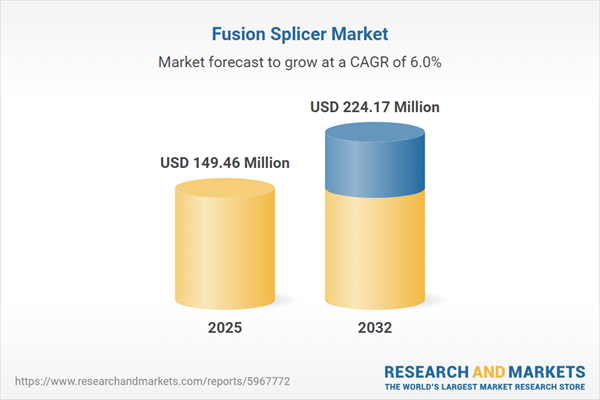Speak directly to the analyst to clarify any post sales queries you may have.
The fusion splicer market is experiencing transformative advancements driven by evolving network architectures, stringent quality demands, and shifts in global supply strategies. Industry leaders are leveraging innovation in splicing solutions to ensure efficient, reliable, and scalable fiber optic infrastructure across sectors.
Market Snapshot: Fusion Splicer Market Growth and Performance
The fusion splicer market grew from USD 140.85 million in 2024 to USD 149.46 million in 2025. It is expected to continue expanding at a compound annual growth rate (CAGR) of 5.98%, reaching USD 224.17 million by 2032. This sustained growth reflects rising demand for high-speed connectivity, precision fiber deployment, and network modernization across telecommunications, data centers, enterprise campuses, and utilities.
Scope & Segmentation
This report provides in-depth coverage of the fusion splicer market, analyzing technologies, applications, end-user profiles, delivery channels, and regional trends. Segmentation includes:
- Application: Cable TV, colocation data centers, hyperscale facilities, enterprise networks, military and defense (defense research and military deployments), telecom (fiber-to-the-home—EPON, GPON; long haul; metro)
- Mode: Multi mode (OM1, OM2, OM3, OM4), single mode (OS1, OS2)
- Cable Count & End User: Data center operators, enterprises, government and defense (including research/academia and military), telecom operators, utilities
- End User Channel: Direct sales, distributors
- Product Type: Ribbon splicers (12+ fiber, 2 fiber, 4 fiber, 8 fiber), single fiber units
- Splicer Type: Bench-mounted, portable models
- Regional Analysis: Americas (North and Latin America), Europe, Middle East & Africa, Asia-Pacific, with detailed country-level perspectives
- Leading Companies: Fujikura Ltd., Sumitomo Electric Industries, Furukawa Electric, AFL Global Holdings, INNO Instrument, Hualu Hengtong Group, EXFO Inc., Viavi Solutions, VeEX Inc., Powercode Telecommunications Equipment Co.
Key Takeaways for Senior Decision-Makers
- Fusion splicer innovation focuses on automating alignment, arc analysis, and error detection, supporting rapid, repeatable splices and streamlining network installations for telecom, enterprise, and utility networks.
- Technological convergence, including AI-powered image processing and remote monitoring, improves quality control and operational efficiency, reducing rework and minimizing field service disruptions.
- Supply chain diversification and regionalized production are becoming essential to manage trade uncertainties and maintain cost-competitive pricing. This is impacting sourcing decisions and long-term vendor partnerships.
- Cloud-based management platforms enable performance analytics, predictive maintenance, and centralized oversight, offering data-driven insights that help control capital expenditures and meet demanding service-level agreements.
- Market segmentation by fiber type, application, and region allows tailored solution design, accommodating unique deployment conditions, from hyperscale data centers to remote military field operations.
Tariff Impact and Strategic Supply Chain Adjustments
Recent tariff changes in the United States have increased costs for critical fiber-optic components used in fusion splicers. In response, manufacturers are shifting subassembly operations to Southeast Asia and Eastern Europe, balancing logistics with the need for quality assurance. These adaptations are leading to more resilient procurement frameworks and encouraging new cross-border partnerships and risk-sharing ventures. End-user organizations are exploring extended warranties, equipment leasing, and remote diagnostics to offset capital expenditure impacts and maintain project timelines.
Methodology & Data Sources
This research employs a rigorous blend of in-depth interviews with industry experts, cross-sectional surveys of end users, and a comprehensive review of technical literature and regulatory filings. Triangulation ensures consistency across multiple data points, and expert peer review validates all findings and interpretations for accuracy and market relevance.
Why This Report Matters
- Enables executives to anticipate trends in fiber network deployment and procurement strategy, supporting informed capital allocation.
- Provides a holistic view of technological advances, regulatory developments, and market segmentation for precise targeting of growth opportunities.
- Equips stakeholders with the strategic context needed to assess risk, return, and supplier alignment amid rapidly changing global conditions.
Conclusion
Advancements in fusion splicer technology and market dynamics are shaping a landscape of increased automation, resilient supply chains, and data-driven operational decision making. Strategic insights in this report position industry leaders to drive connectivity progress and sustainable organizational growth.
Additional Product Information:
- Purchase of this report includes 1 year online access with quarterly updates.
- This report can be updated on request. Please contact our Customer Experience team using the Ask a Question widget on our website.
Table of Contents
3. Executive Summary
4. Market Overview
7. Cumulative Impact of Artificial Intelligence 2025
Companies Mentioned
The companies profiled in this Fusion Splicer market report include:- Fujikura Ltd.
- Sumitomo Electric Industries, Ltd.
- Furukawa Electric Co., Ltd.
- AFL Global Holdings, LLC
- INNO Instrument Co., Ltd.
- Hualu Hengtong Group Co., Ltd.
- EXFO Inc.
- Viavi Solutions Inc.
- VeEX Inc.
- Powercode Telecommunications Equipment Co., Ltd.
Table Information
| Report Attribute | Details |
|---|---|
| No. of Pages | 188 |
| Published | October 2025 |
| Forecast Period | 2025 - 2032 |
| Estimated Market Value ( USD | $ 149.46 Million |
| Forecasted Market Value ( USD | $ 224.17 Million |
| Compound Annual Growth Rate | 5.9% |
| Regions Covered | Global |
| No. of Companies Mentioned | 11 |









